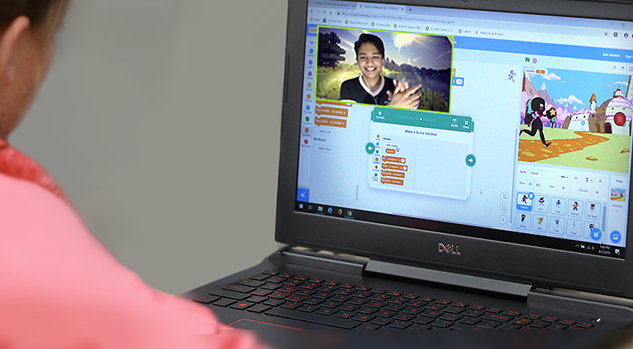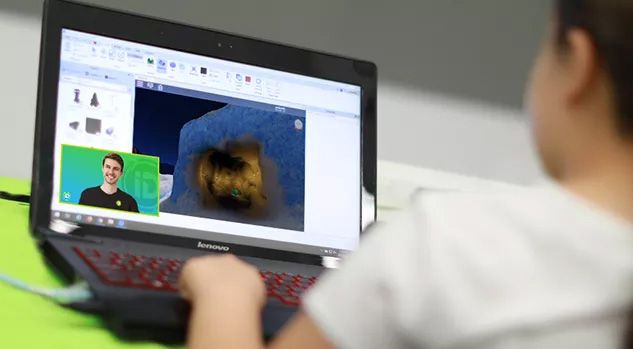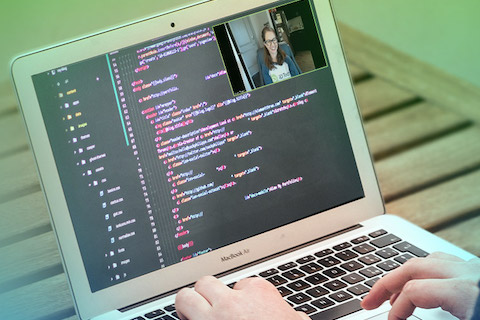Parents, let’s be real—learning to code can feel overwhelming at first. With so many languages out there, how do you even know where to start? The good news? Learning to code can actually be fun—and your child might surprise you with what they create. With the right language (and the right class or lesson), they could be designing a game, coding a website, or even building an AI project in no time.
In this guide, we’ll break down the best coding languages for kids in 2025, from visual coding tools to pro-level programming. Whether your child dreams of designing games, building apps, or just exploring how coding works, there’s a perfect place to start.
Here are the best coding languages for kids in 2025, followed by detailed descriptions for each, and suggestions in terms of the best coding classes for kids. W
- Scratch
- Python
- JavaScript
- Lua
- Java
- C#
- C++
1. Scratch & other visual programming languages:
Perfect for absolute beginners
If your child has never coded before, Scratch is the ideal launchpad. By snapping together colorful "drag-and-drop" blocks of code, kids can bring games, animations, and stories to life—without worrying about syntax errors.

Best of all, the simplicity of Scratch gets kids excited about coding! Visual programming languages can be used to make interactive stories, games, and animations.
In 2025, Scratch is still the gold standard for beginners—but it’s not the only visual coding tool out there. Kids also love platforms like Tynker (great for Minecraft modding) and Microsoft MakeCode (awesome for coding hardware like micro:bits).
Best for:
- Ages 7-10
- Visual learners
- First-time coders
Read more: How to Make a Scratch Game
Featured courses:
- Scratch Tutoring (ages 7-9)
- Coding 101 Camp (ages 7-9)

2. Python
Best for beginners (and for versatility!)
Python’s popularity just keeps growing, and for good reason—it’s beginner-friendly, yet powerful enough for AI, data science, game development, and more. Python's clean syntax makes it one of the easiest text-based languages to read and write.

Companies like Google, Netflix, and Disney use Python, and it’s very popular in scientific fields, where individuals are scientists first and programmers second. This language can be used to develop video games, web frameworks, and many scientific and numeric computing projects.
Python programming is great for kids, and is also versatile enough to be used in intricate fields like cybersecurity and artificial intelligence. Now that’s a flexible and powerful language!
Python is also the language behind many AI and automation tools, which means kids who learn Python today will be ahead of the curve for tomorrow’s tech careers.
Best for:
- Ages 10+
- Kids curious about AI, gaming, or app development
- Future scientists, data analysts, and cybersecurity pros
Read more: Easy Games to Make in Python
Featured courses:
- Python Tutoring
- Machine Learning Tutoring
- Python Coding 101 (ages 10-12)
- Python Camp: Intro to Coding & AI (ages 13-17)
- Machine Learning & Data Science Academy with Python (ages 13-18)
And now that you've read about the two languages, check out the comparison of Scratch vs. Python.
 3. JavaScript
3. JavaScript
Best for kids who want to build websites or web games
JavaScript powers much of the interactive content on the web, and it’s a great choice for kids interested in web development or browser-based games. With frameworks like p5.js, kids can create interactive art, while basic game engines like Phaser make it easy to design web games.

Tweens and teens love using JavaScript with HTML/CSS to build personal websites, design games, and show off their creativity online.
Best for:
- Ages 10+
- Future web developers and game designers
- Kids who love creative design
Read More: Python vs. JavaScript
Featured courses and lessons:
- Javascript Tutoring (ages 10-19)
- Hacking with JavaScript (ages 10-19)
- JavaScript Coding & Game Design (ages 11-16)
4. Lua (for Roblox)
Best for game programmers
If your child dreams of designing their own Roblox games, Lua is the language to learn. Lua is lightweight, easy to embed, and tailor-made for game scripting inside Roblox Studio. Plus, Roblox continues to dominate the UGC (user-generated content) gaming space, and kids love turning their creative ideas into playable worlds.

With Roblox Studio and Lua, kids can design their own games, share them with millions of players, and even earn Robux if their games become popular. It’s creative coding with real-world rewards.
Is Lua easy to learn?
With a short learning curve (like Python), ease of embedding, and rapid execution, Lua is an ideal choice when it comes to activities like learning how to code a game.
The number of developers using Lua is steadily increasing, which means your student can pick up a tool that can serve them across a number of careers; Adobe Photoshop, World of Warcraft, and Angry Birds all utilize Lua code.
Best for:
- Ages 8+
- Aspiring game developers
- Roblox enthusiasts
Read more: How to make an Obby in Roblox!
Featured courses:
- Roblox Game Design: Make Your Own Obby (ages 7-9)
- Roblox Developer: Lua Coding and Game Design (ages 10-12)
- Roblox and Lua Coding
5. Java (Minecraft coding language)
Best for intermediate students and Minecraft fans
Java is one of the most widely used programming languages in the world, with analysts saying that about 90 percent of Fortune 500 companies leverage Java. So it’s a great option for students who want a rich understanding of coding that can be built upon for years to come.

Java is a statically typed language, meaning it requires you to specify a variable type. While this means that apps built with Java are known to be more scalable, stable, and maintainable, it also means that Java can take longer to master than other languages.
Java is good for kids because it can be used to make game engines, Android mobile apps, large backend environments, and much more. Java is also the language used in AP Computer Science A, so Minecraft modding is actually an amazing way to start building skills for future classes.
Even if your child moves beyond Minecraft, the skills they gain in Java will help them with app development, backend programming, and college-level coding courses.
Best for:
- Ages 10+
- Kids ready for more complex coding concepts
- Minecraft modding enthusiasts
Read more: How to Practice Java Online
Featured courses:
- Java Camp: Intro to Computer Science (ages 13-17)
- Java Coding: Build Mods with Minecraft (ages 10-12)
- Computer Science with Java (ages 13-19)
- Java Camp: Intro to Computer Science (ages 13-17)
- Java Tutoring (ages 10-19)
6. C# (for Unity Game Development)
Best for 3D game development
Pronounced "see sharp," C# is an extremely popular programming language that’s used to develop most third-party applications for Windows. It’s the fourth most in-demand programming language for jobs, and can be a great starting language for people who are new to coding.
Syntactically, C# is very similar to Java, so experience in using one of these languages will make it easier to pick up the other. C# can be used to create web applications, games, and other programs.
With Unity, it isn’t just for regular games—it also powers VR, AR, and tons of indie hits on platforms like Steam. Your child could be coding the next big thing in gaming or immersive tech.
Best for:
- Ages 12+
- Aspiring game designers & developers
- Kids who want to learn coding with visuals and physics
Featured courses:
- Unity with C# Tutoring (ages 13-19)
- VR Game Design with Unity and Meta Quest (ages 13-17)


7. C++
Best for teens serious about computer science
Pronounced “see plus plus,” this programming language is used to create applications that run locally on machines such as your computer.
Despite the time and complexity required to learn C++, this language will provide teens with a very deep understanding of programming. C++ can be used to create systems software, games, and a variety of other programs.
C++ powers Unreal Engine, which is behind blockbuster games like Fortnite. For teens dreaming of careers in game development, C++ is a must-have.
Best for:
- Ages 13+
- Advanced students preparing for AP Computer Science or college CS programs
- Future software engineers and game developers
Read more: C++ for Kids & Teens
Featured courses:
- Game Coding Academy with C++ (ages 13-18)
- C++ Tutoring Online Private Tutoring (ages 10-19)
So with all of that, how do you go about making your coding language selection?
How to choose the right programming language
- Think about the outcome. What does your child want to make?
- Look for transferable skills. Some languages unlock more options later.
- Match the skill level. Start simple for beginners.
- Or just dive in! The most important step is getting started.
| Child’s Goal | Best Language |
|---|---|
| First coding experience | Scratch |
| Build a Roblox game | Lua |
| Make a website | JavaScript |
| Mod Minecraft | Java |
| 3D game design | C# |
| Explore AI or data science | Python |
| Serious CS prep (AP or college-level) | C++ |
Details:
Think about it—many students are required to study a foreign language at some point in their academic career. So how do you decide which foreign language to choose? Will it be Spanish or German? Mandarin or Cantonese? Or maybe even Swahili?
Choosing the right programming language for your child is similar. Here are some of the ways you can go about it!
Choose based on output
If your child is planning for a long vacation in Germany, he might want to study German. Similarly, if your child dreams of designing video game elements, he might want to study C++ or Blueprints, which is Unreal Engine’s visual coding language.
Choose based on transferability
People often recommend studying the romance languages, as they all come from the same root language, and learning one of these languages can make it easier to learn the others. Similarly, sometimes learning one programming language, like Java, can set you up to learn others more quickly and efficiently down the line.
Choose based on skill level
Learning to write in Spanish, which features an English-like alphabet and grammatical structure, is much easier than learning to write Japanese kanji, which includes thousands of unique characters.
Likewise, learning a coding language like Python is great for beginners, as it’s easier to get up and running without worrying as much about syntax.
Just choose!
Sometimes there’s no clear direction on what language your child should start out using. That’s okay! Students can learn important programming principles from any coding language, so you don’t need to worry about choosing the wrong one. If your child is interested in coding, just let them get started!
Give your child a creative edge!
There are numerous reasons why kids and teens should learn to code. Improve your child's computational thinking skills, creativity, and if-then reasoning with a week of programming instruction at an iD Tech program. There are a wide range of summer programming courses for kids and teens ages 7–18 (and online coding courses for kids and teens), spanning many coding languages.
Every one of these languages will help students better understand programming principles and get excited about coding. For more help selecting a course, you can reach out to our Camp Specialists. They love helping families like yours every day!
Not sure where to start? Take our quick Course Finder Quiz and we’ll recommend the perfect class based on your child’s age, interests, and experience. Or, chat with a friendly iD Tech Specialist—we’re here to help every step of the way.
